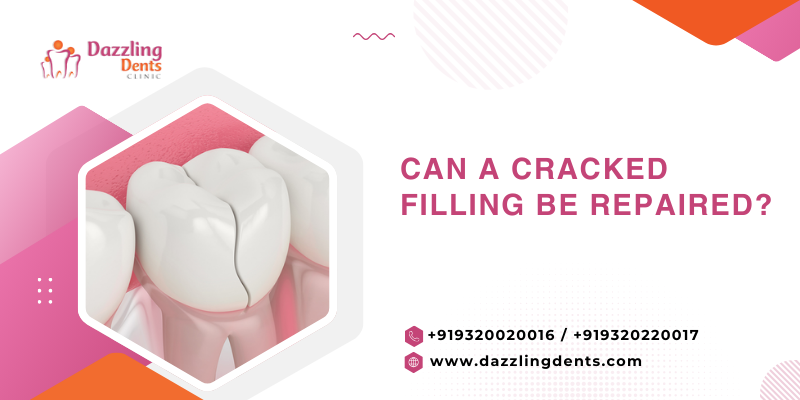


Picture this: you’re enjoying a plate of hot jalebi and crunchy samosa in Dombivli, life is good… until you feel something sharp in your mouth. Nope, it’s not an extra-crispy bit, it’s a piece of your filling.
If you’ve ever had this “oh no” moment, you’re not alone. Cracked fillings are surprisingly common, and the good news is, yes, they can often be repaired. But the real question is how, when, and with what?
In this blog, we’ll break down the basics of repairing a cracked filling, why tooth colored filling in Dombivli is a popular choice, and how to avoid this sticky situation in the future. We’ll also walk you through your options with help from the expert hands at Dazzling Dents Dental Clinic, led by Dr. Pankaj Desale, where fixing a cracked filling is not just about restoring your tooth, but your peace of mind (and your jalebi sessions).
Fillings are strong, but they’re not indestructible. Over time, everyday wear and tear, biting into something too hard, or grinding your teeth can cause them to crack. Even temperature changes, like alternating between hot chai and ice-cold soda, can make fillings expand and contract, leading to tiny fractures.
Old fillings are especially vulnerable, and if they’ve been in place for years, small cracks may go unnoticed until they give way completely.
Not all cracked fillings announce themselves dramatically by breaking mid-bite. Sometimes, the signs are subtle, but catching them early can save you from bigger dental trouble. Here’s what to look out for:
Ignoring these signs can allow bacteria to sneak in, leading to decay beneath the filling and possibly requiring more complex treatment later. If you notice any of these symptoms, it’s best to get your tooth checked by your dentist right away.
Yes, in most cases. The repair method depends on:
At Dazzling Dents Dental Clinic, Dr. Pankaj Desale often uses tooth colored fillings to repair or replace cracked ones. They blend perfectly with your natural teeth, are durable, and restore your tooth’s function without making it look “fixed.”
Tooth colored fillings, sometimes called composite fillings, aren’t just pretty; they’re practical. If you’ve ever wondered what the white filling dentists use, this is it. Made from a special resin, they match the shade of your teeth so well that no one can spot the repair.
Benefits include:
A cracked filling repair is usually a short and straightforward appointment:
You’ll walk out being able to smile, talk, and eat comfortably again.
A repaired filling can last you many years, but only if you treat it right. Here are some dentist-approved ways to protect your investment:
Think of your tooth-colored filling as a long-term partner for your tooth. It’ll stay strong and loyal if you treat it well.
Yes! Tooth colored fillings, or composite fillings, are designed to blend seamlessly with your natural teeth. They’re especially popular for front teeth repairs, but work equally well for molars.
They can be slightly more expensive than traditional silver (amalgam) fillings, but the benefits, like aesthetics, better bonding, and preservation of tooth structure, often make them worth the investment.
With proper care, they can last anywhere between 7 and 10 years or longer. Regular dental visits and avoiding habits like nail-biting or chewing on pens can extend their lifespan.
Yes, but dentists usually recommend waiting until the numbness wears off to avoid biting your cheek or tongue accidentally. Composite fillings set instantly with light curing, so you can resume eating soon after.
Absolutely. In fact, you should. Just be gentle around the repaired tooth for the first day and use a soft-bristled brush. Good oral hygiene helps your filling last longer.
A cracked filling isn’t just a cosmetic issue; it can expose your tooth to bacteria and cause further damage. The sooner you get it fixed, the simpler (and cheaper) the solution will be.
If you need a tooth colored filling in Dombivli, Dazzling Dents Dental Clinic is your go-to. Dr. Pankaj Desale’s expertise ensures your repair is strong, natural-looking, and built to last, so you can go back to enjoying your favorite foods without worry.
Visit Dazzling Dents Dental Clinic today and get your cracked filling repaired the right way because your teeth deserve both strength and style.